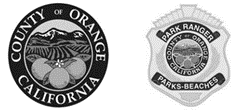The Trademark Trial & Appeal Board (Board) issued a precedential decision affirming the US Patent & Trademark Office (PTO) Examining Attorney’s refusal to register two different logo marks filed by southern California’s County of Orange because the marks consisted of and comprised, respectively, an insignia of a municipality. The Board found that a logo adopted by a government entity does not have to be “official” to constitute an insignia for which trademark registration is prohibited under Section 2(b) of the Trademark Act, 15 U.S.C. §1052(b). In re County of Orange, Ser. Nos. 87419378; 87639750 (TTAB, Aug. 4, 2022) (Shaw, Coggins, Allard, Administrative Trademark Judges).
The County applied to register two logo marks. The US trademark applications described one mark as “a circle with the image of three oranges in front of an orange grove and . . . mountains with the words ‘COUNTY OF ORANGE’ . . . and . . . ‘CALIFORNIA’ . . . [around] the circle” (Circle Mark). The second logo mark featured a park ranger badge design that encompassed the Circle Mark in its entirety.

The PTO examining attorney refused registration of both logo marks under Section 2(b), which imposes an absolute bar on registration on either the Principal or Supplemental Register of a mark that “[c]onsists of or comprises the flag or coat of arms or other insignia of the United States, or of any State or municipality, or of any foreign nation, or any simulation thereof.”. This section reflects the sentiment that such symbols are indicia of government authority that ought to be reserved solely for signifying the government, and which should not be registered as symbols of origin for commercial goods and services.
On appeal to the Board, the County argued that the logo marks did not constitute “insignia” because they were not an “official” seal of the County, and, even if they were, registration should not be precluded because the County is not a “municipality.” Considering both of these arguments in turn, the Board provided analysis specific to both the circle and badge iterations of the applied-for logos.
The County argued first that the proposed marks could not constitute an insignia of Orange County, California, because the County created and adopted an official seal (a design of an orange having a stem with three leaves) more than a century ago, in accordance with the applicable state government code requiring a two-step process for adopting an official seal.

The Board found this argument unpersuasive, noting that although the Circle Mark had not undergone the state’s two-step process to become an “official” seal, Section 2(b) does not distinguish between “official” and “unofficial” insignia. Therefore, formal adoption of an “official” seal is not required for an insignia to otherwise fall under the Section 2(b) bar to registration.
The Board explained that the County uses the Circle Mark for a plethora of official government business and pointed to the Circle Mark displayed on each page of the official County website—a portal for many key government services and a site that includes the web page for the County Board of Supervisors (where the mark is also displayed on the supervisors’ meeting room wall). The Board also pointed to the website and roadway signage of the Clerk-Recorder’s office, physical signage for certain County government offices (including the Superior Court of California), and to map of the County Civic Center depicting several government facilities. The Board found that members of the public would be likely to perceive the applied-for Circle Mark as an insignia of the County because the County prominently displayed the mark to signify County authority and to demarcate records, functions and facilities, and because such use of the Circle Mark (dating back as early as 1948) is “prominent and repeated.” As such, the Circle Mark was deemed to constitute an insignia within the meaning of Section 2(b).
The Board’s rejection of the County’s argument that it is not a “municipality” for purposes of the Section 2(b) registration refusal relied on the PTO Examining Attorney’s definition of “municipality” as “[a] political unit, such as a city, town, or village, that is incorporated for local self-government,” and third-party evidence from ballotpedia.org identifying the County as a “charter county of the state [recognized] as its own governmental body.” The Board further accepted the Examining Attorney’s argument that evidence from the County’s own website identifies it as a local governmental authority functioning as a municipality. Again, dismissing a highly literal application of Section 2(b), the Board rejected the County’s argument that it is not formally “incorporated” for purposes of fitting into the Examining Attorney’s “municipality” definition. The Board explained that the exact nature and timing of the formation of the County is irrelevant as to Section 2(b) because evidence has shown that the County has power of self-government. Therefore, the Board held that the County is a “municipality” for the purpose of determining whether its Circle Mark is blocked from registration under Section 2(b).
Finally, the Board found examples of other trademarks registered by the County containing some of the same elements of the Circle Mark to be unpersuasive. These prior registrations were deemed to be used or perceived in a different manner or found to be visually distinct from the Circle Mark.





